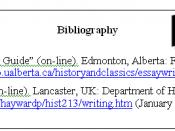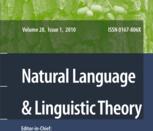Guidelines for linguistics assignments: Linguistic examples and bibliographies Andrew McIntyre
1. Citing linguistic examples When writing on linguistic subjects, it is useful to distinguish object language (the
expressions you are talking about) from metalanguage (expressions you are using to talk about the object language expressions). Therefore, object language expressions are put in italics if you are using a computer (and underlined if hand-written). E.g.
The verb give can take two NP complements (for instance as in I gave Mary the book) or a single NP and a to-PP (e.g. I gave the book to Mary).
A useful standard practice is to write linguistic examples on a separate line and provide them with numbers, which you can refer to in your text. Examples given in this form need not be written in italics, though they can be. An example is as follows:
The sentences in (1) below illustrate the dative alternation in English. (1a) is an instance of the double object construction and (1b) instantiates the to-construction.
(1) a. John gave Mary a book. b. John gave a book to Mary.
The structures in (1) seem to have an identical interpretation in which the agent John causes the indirect object in (1a) or the complement of to in (1b) to possess the book.
Nevertheless, not all structures involving possession transfer are acceptable in the double object construction, cf. (2).
(2) *Francine donated the library a book. Foreign language examples: Examples from languages other than English, French or
German should be accompanied by a literal gloss, a word-for-word translation of each morpheme in the example, and an idiomatic gloss, indicating the overall meaning of the expression. Examples:
(3) Ne arrivano molti [Italian] of.them arrived many
'Many of them arrived.' (4) Taroo-ga niku-o koor-ase-ta [Japanese]
Taro-NOM meat-ACC freeze-CAUSE-PAST 'Taro froze the meat.' In...


